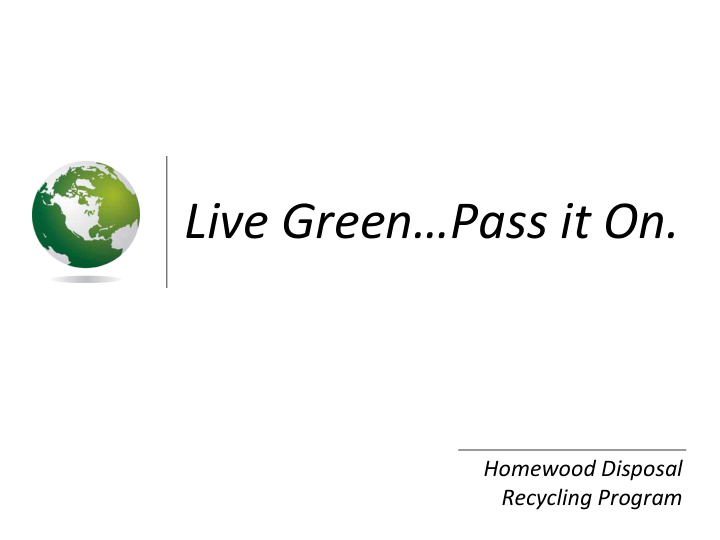



Live Green…Pass it On. Homewood Disposal Recycling Program
Taking it to the Curb Garbage, Yard Waste, and Recycling is picked up by three different trucks every week (or every other week). One truck collects garbage, another takes the yard waste and another will take the recyclables. Each material is brought to specific locations where it is processed.
Garbage Once the garbage is picked up from the curb, it is brought to our transfer station. A transfer station is where the drivers can take the material without having to drive long distances. The garbage gets loaded into large semi trailers which then take the material to the landfill.
What is a landfill? Landfills are different from dumps. Years ago the garbage would just be thrown in a large hole or dump. Now the garbage is taken to carefully designed structure that is built into the ground. Landfills are isolated from the surrounding environment (like groundwater, air, and rain). This isolation is accomplished with a bottom liner and daily covering of soil.
Running out of room Landfills are very large and they can’t be built just anywhere. We are quickly running out of room to put all of this garbage. Instead of building new landfills in our neighborhoods, we had to come up with another way to get rid of all the garbage. That is where the 3 R’s come in…
What is Recycling? Recycling is when we make new products out of old ones that would instead go to the landfill.
How Can I Tell if Something Can be Recycled? Most recyclable products are marked with a symbol. Many plastic containers have a symbol with a number inside which is the type of material is it.
What Can I Recycle? Newspapers, School Papers, Phone Books, Magazines, Envelopes, Junk Mail, Computer Paper, Cardboard and Paper Bags. Plastic containers marked #1-7 (excluding #6). Including pop/water bottles, milk and juice jugs, household cleaners, butter tubs, yogurt containers. Glass Bottles & Jars Tin and Aluminum Cans
How Does It All Work? Once the recycle truck picks up the recycling from your home, it is brought to our recycling facility. Here, the workers sort the material to make sure no garbage was mixed in with the recyclables. They also separate the material into groups for shipping.
What Happens Next? Next, the material is loaded into our baler. This machine compacts the material and creates a bale of material. Once the bale is large enough, a wire cuts it off and bundles it to keep it together
Take it Away Once the material is put into bales, we pile it up and wait for it to be taken away. A forklift comes and loads the material into a semi trailer. The semi trailer takes the material to different places to be recycled.
New Products Newspapers Sent to China to be made into more newspaper Magazines Toilet paper and Kleenex Pop Bottles Yarn, carpeting, and different plastics (school supplies) Laundry Soap Bottles Playground equipment, park benches, plastic lumber Aluminum Cans Bicycles, siding, cans, cookware Tin Cans Sheet metal to be used on numerous products Glass New glass bottles and jars
Yard Waste Yard waste (grass, leaves, branches, brush) is also recycled. In Illinois it is illegal to mix garbage and yard waste in the landfill. Instead, yard waste is collected separately and brought to a composting site. What is composting: A mixture of decaying organic materials used as fertilizer or fill material.
Other Options Just because Homewood Disposal can’t take ALL materials as recycling, doesn’t mean they can’t be recycled or reused. Stores and other organizations can offer recycling services for things like ink cartridges, plastic bags, batteries, light bulbs, electronic waste, etc. Another option would be to reduce or reuse the amount of things you use at home. If you can’t use paper bags, try to use plastic bags multiple times, use glass cups instead of plastic or styrofoam cups, use dinner plates instead of paper plates, etc.
Questions Live Green…Pass it on.
Recommend
More recommend